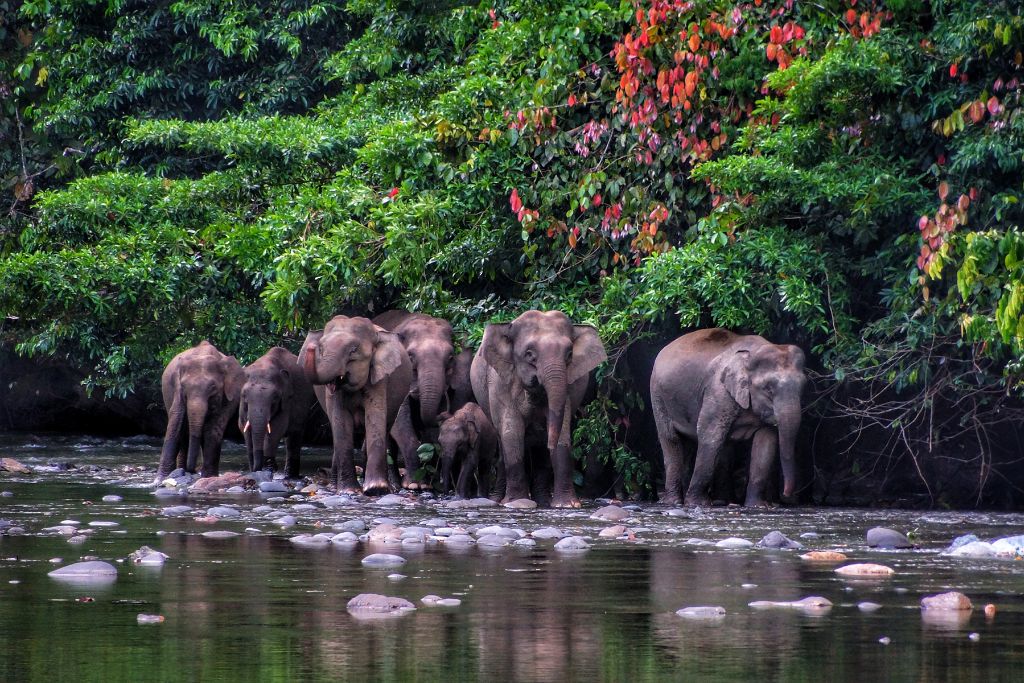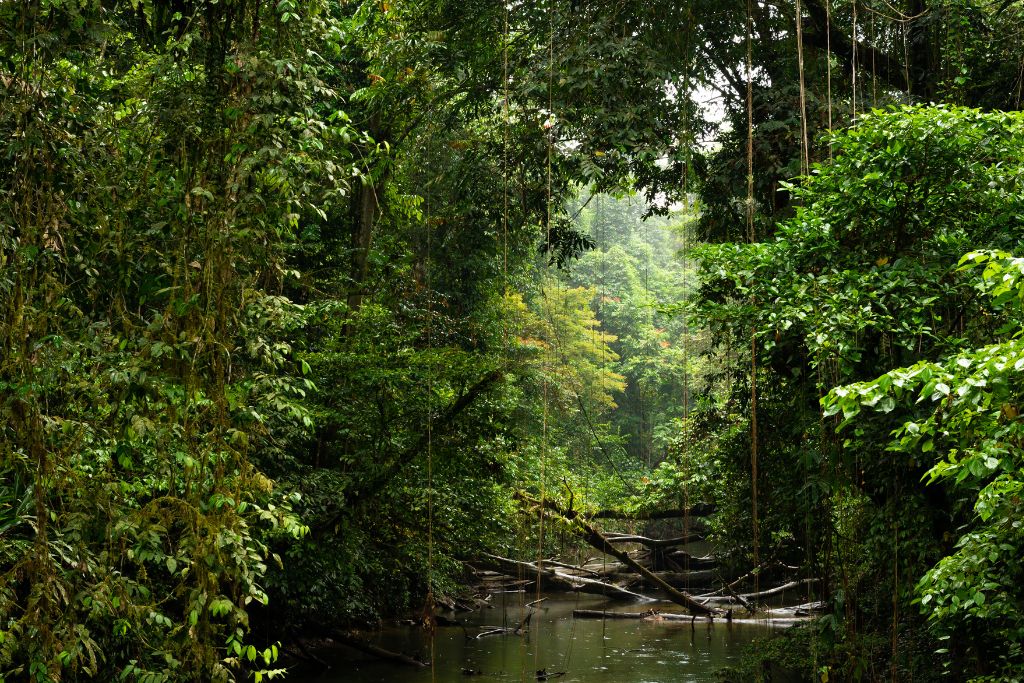Borneo is home to some of the planet’s most ancient rainforests, containing concentrated numbers of diverse and endemic species. Unfortunately, decades of logging, land clearing, and agricultural conversion mean that only 50% of this rainforest still remains. Despite the disastrous consequences of deforestation in Borneo, including habitat loss, degradation, and fragmentation, conservation efforts of numerous parties active on the Southeast Asian island give us hope for the island’s irreplaceable rainforests and species.
—
Deforestation in Borneo
Although dense rainforests once blanketed Borneo’s entirety, deforestation has laid claim to increasing amounts of the island and contributed to the endangerment of species dependent on its forests. These threats are certainly not unique to the region. A 2020 study indicates that 50% of the Bornean rainforest was lost between 1973 and 2015. To recognise why this is so devastating, it is essential to understand why the giant Southeast Asian island is so important.
Maritime Southeast Asia comprises three of the world’s 17 megadiverse countries: Indonesia, Malaysia, and the Philippines. Borneo is split between Indonesia (about 73%), the two Malaysian states of Sarawak and Sabah to the north (around 26%), and tiny Brunei, surrounded by Sarawak. Its remarkable lowland rainforests are the planet’s second-oldest rainforest ecosystem, clocking in at around 140 million years old – second only to the Daintree, and twice as ancient as the Amazon.

Borneo contains the highest levels of Southeast Asian plant and mammal species richness.
As with all megadiverse regions, the territory boasts a stunning array of diverse and endemic fauna and flora. Researchers have identified Borneo as containing “the highest levels of [Southeast] Asian plant and mammal species richness.” Native mammals include the Bornean clouded leopard, Borneo bay cat, Borneo sun bear, pygmy elephant, Borneo rhinoceros, and the Bornean banteng, with endemic primates featuring the orangutan (found only in Borneo and Sumatra), the southern grey gibbon, and the proboscis monkey. Unique plants include the Rafflesia arnoldii, producing the world’s largest flowers. In addition to its impressive number of distinctive species, it is also one of Southeast Asia’s major evolutionary hotspots.
You might also like: Top 10 Critically Endangered Species in Asia in 2022
Deforestation and Palm Oil in Borneo
Deforestation leads to three of the worst threats to biodiversity: habitat loss, land degradation, and habitat fragmentation.
The world’s rainforests are logged, burned, and cleared for agricultural conversion (to establish palm oil plantations, for instance). The clearing of trees and their root systems, affecting soil structure and fertility, is a main contributor to eroded and degraded soil. Another threat to species globally is habitat fragmentation. Their habitats become fragmented through human land transformation, creating smaller, more isolated fragments.
A Science Advances article details how “all aspects of fragmentation – reduced fragment area, increased isolation, and increased edge – [have] degrading effects on a disparate set of core ecosystem functions.” In addition to this habitat destruction, other threats to Borneo’s mammals include hunting and wildlife trade.
Regarding agricultural output, Malaysia and Indonesia supply about 87% of the world’s palm oil. Derived from oil palm trees (Elaeis guineensis) – native to West Africa and introduced to Southeast Asia in the 1800s – palm oil is a multipurpose vegetable oil. It is involved in the manufacture of everything from processed foods to personal care and cleaning products. Further, Palm Oil Investigations and the World Wildlife Fund (WWF) estimate that the oil and its derivatives are found in 50% of supermarket products consumers use on a daily basis. It’s also employed as an alternative biofuel.
You might also like: Palm Oil Deforestation: Origins, Environmental Degradation and Solutions
Perhaps unsurprisingly, the world has seen a steady rise in palm oil production over the last few decades. Annual supply increased by nearly 50 million tonnes from 1995 (15.2 million per annum) to 2015 (62.6 million per annum). Related to these statistics, between 2000 and 2018, roughly 39% of Bornean tropical forests were converted into palm oil plantations. In fact, with 8.2 million hectares of plantations, Borneo produces the most palm oil of any world region. More rainforest land is cleared for cultivating timber, rubber, pulpwood, and acacia (the fire-resistant acacia is native to Australia but has been introduced to Borneo).
Undeniably, the high global demand for palm oil has degraded, fragmented, and destroyed habitats for the island’s species and residents. But it is important to note that palm oil has also lifted hundreds of thousands of Borneans out of poverty. While native communities have co-existed with the rainforests for millennia, subsisting in mutual harmony, “this way of life is dying,” as Emma Maxwell writes in a piece on the truth of Borneo’s plantations. Despite these changes, nature, generally speaking, still holds both cultural and spiritual significance for indigenous peoples around the world, such as the Dayaks of Borneo.
In a 2013 study among Bornean villagers, small-scale land clearing was viewed more positively than mass deforestation (such as for palm oil and acacia cultivation). Opinions about the latter were more context dependent. The conflicting desires for both economic growth and ecological sustainability – is there ever a simple solution?
You might also like: The Conservation Organisation Working to Restore the Borneo Rainforest One Tree at a Time
Current Rainforest Loss and Conservation Efforts on Borneo
In the mid-1980s, around 75% of the Bornean rainforest was still untouched. Currently, only half of the island’s original forest still remains. As mentioned previously, according to a Frontiers paper titled “Impacts of Four Decades of Forest Loss on Vertebrate Functional Habitat on Borneo”, 50% of the territory’s rainforests were lost during the years 1973–2015.
Forty years is a long time. And there is hope that deforestation will decline. It was mostly during the 1980s and 1990s that Borneo’s rainforests were levelled at astonishing rates (for example, Kalimantan lost 56% of its protected rainforest between 1985 and 2001). Moreover, according to a 2018 report by the Center for International Forestry Research (CIFR), since the year 2000, many Bornean agricultural plantations were established on land cleared before 2000. The researchers suggest that, in 2017, rainforest clearing specifically for plantation expansion – as well as agricultural conversion more generally – was at its lowest since 2003. Lastly, the CIFR report also indicates that while rainforest loss for any purpose peaked in 2016, the next year saw a sharp decline.
Although the situation is not as dire as during the 1980s or 1990s, NGOs including the WWF warn that logging, land clearing, and plantation expansion are still ongoing issues for Borneo, as they are for many tropical regions. Meanwhile, various not-for-profits and initiatives are pushing to conserve and restore the island’s ancient rainforests.
To protect its species, the WWF has established a Heart of Borneo programme. The initiative – commenced in 2007 via a joint declaration between the organisation and the Indonesian, Malaysian, and Bruneian governments – seeks to create protected areas and enhance sustainable forest management in Borneo’s core; the island is one of WWF’s focus areas, containing five priority species.
You might also like: The Orangutan Project Celebrates International Women’s Day by Recognising Borneo’s First Women Ranger Teams
For many endemic cat and primate species, Borneo’s peatland swamp forests are crucial habitats. The International Tropical Peatlands Center works throughout Southeast Asia, the Congo Basin, and Peru, including in Borneo, to sustainably conserve and manage peat-swamp forests.
Another conservation organisation active on the island is the Borneo Nature Foundation (BNF), founded in 1999. Many of deforestation’s worst effects can be reversed through reforestation, the replanting of trees. Reforesting, also in Borneo’s peatland swamps, is one of many efforts undertaken by the non-profit. They also conduct field research and surveys to identify forests with cultural significance and High Conservation Value, thus safeguarding these habitats for both wildlife and local communities. BNF also engages in fire-fighting and fire prevention to further conserve Borneo’s ancient rainforests. In addition to their forest protection efforts, they conduct scientific research into the island’s fauna and flora – including orangutans, other primates, and wild cats. The non-profit also runs community development and environmental education in Borneo.
Likewise, The Borneo Project works with local communities, training indigenous activists to demarcate their ancestral land, thereby preventing the conversion of this territory into plantations. Similar to the BNF, their mission is to conserve and protect the island’s habitats for people and wildlife alike, whilst defending human rights. And a recent Earth.Org article spotlights The Orangutan Project, a charity operating for over 20 years to save the unique Bornean primate.
However, conservation efforts face threats of their own. Perhaps it comes as little surprise, but the “continuous flow of large amounts of capital into deforestation” is a major one.
According to the UN Environment Programme (UNEP), the UN drafted their Principles for Responsible Banking – whose current signatories make up nearly half the world’s banks – with the hopes of achieving some systemic change. The goal is to nudge these institutions into alignment with the UN’s Sustainable Development Goals and the Paris Agreement. A second threat confronting sustainability initiatives takes the form of local governments (secretly) granting agricultural conversion concessions to companies. This occurred between the Sarawak government and Radiant Lagoon in 2018. Public protests arose in response, resulting in the cessation of clearing.
In summary, thanks to the numerous ongoing conservation efforts of diverse parties, Borneo’s ancient rainforests and unique species will be protected, preserved, and restored for generations to come.
You might also like: State of the World Forests 2022: Why Swifter Action Is Needed to Halt Deforestation


















